We explain what the Roman Empire was, its characteristics and the dynasties that ruled it. In addition, we discuss the fall of the empire and its culture.
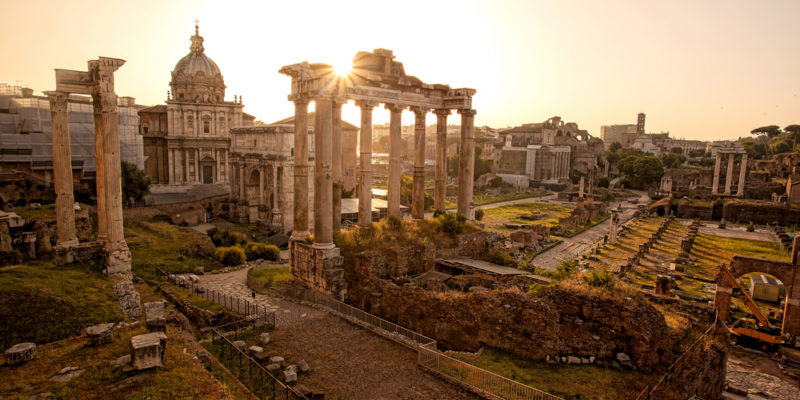
What was the Roman Empire?
The Roman Empire marked the last of the three periods in the history of Roman civilization. The Romans were an ancient civilization that settled in the Italian peninsula and conquered a great part of Europe, North Africa and the Near East. Although their history had begun seven centuries earlier, the imperial period spanned from 27 BC to 476 AD in the West, and until 1453 AD in the East.
This period was named the "golden centuries" by classical historians, as Rome established itself as the dominant power over the Mediterranean Sea, North Africa, West Asia and Southwestern Europe.
The Roman Empire was characterized by an autocratic government in which administrative, political, military and religious powers were in the hands of an emperor. Throughout its imperial history, different dynasties ruled Rome and imposed their distinct style on Roman society.
- See also: Ancient Egypt
Characteristics of the Roman Empire
The main characteristics of the Roman Empire were:
- It lasted between 27 BC and 476 AD in the West, and until 1453 AD in the East.
- It was structured around the figure of the emperor.
- It was ruled by four imperial dynasties during the High Empire, and another three during the Low Empire.
- It had social hierarchies based on wealth as a means to attain positions of power.
- It had a dynamic economy, structured around taxes and trade.
- It developed an artistic, literary and architectural culture that laid the foundation for all other Western societies.
Geographical location of the Roman Empire
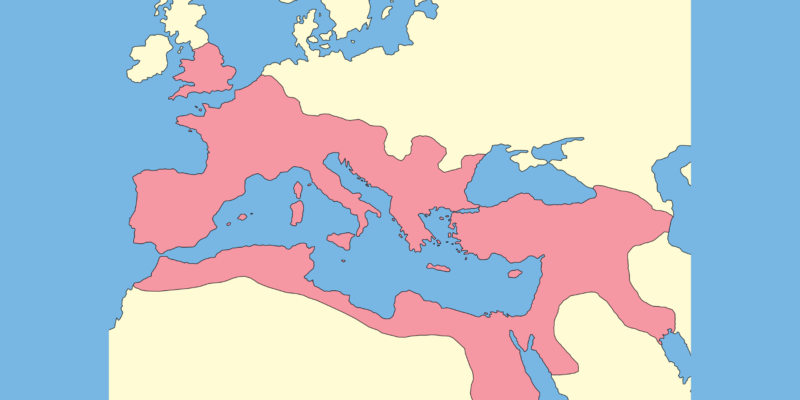
The Roman civilization occupied the European Italian peninsula. Through conquests, the Roman Empire came to control most of Europe, the Mediterranean coast of Africa, and the inhabited areas of the Near East.
The northern border was defined by the Rhine and Danube rivers, the western border by the Atlantic Ocean, the eastern border by the Asian Red and Black Seas, and the southern border by the African Sahara Desert.
Origin and history of the Roman Empire
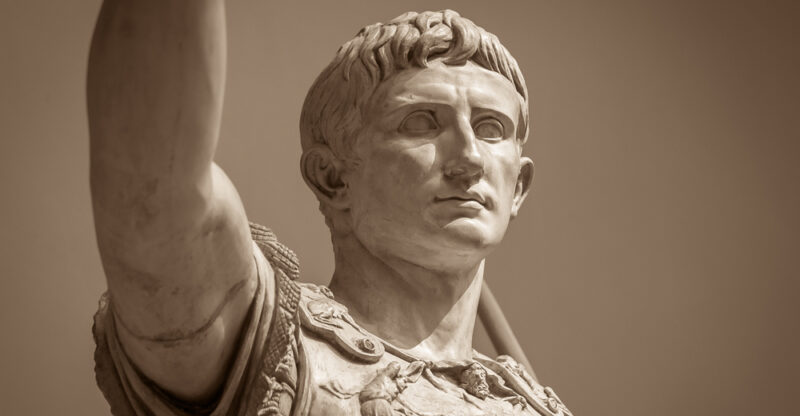
The history of Roman civilization is divided into three major periods corresponding to its form of government: the Monarchic Period (753-509 BC), the Republican Period (509-27 BC), and the Imperial Period (27 BC-457 AD/1453 AD).
Background
During the Republican period, the Romans waged a series of campaigns of conquest, establishing themselves as a power in the Mediterranean region. This period was marked by senatorial rule. In the first century BC, internal conflicts and power disputes led to a political crisis, during which the generals of the Roman army gradually amassed greater power, undermining the senatorial aristocracy.
Julius Caesar was the first general to overpower the senators and demand extraordinary powers: he was appointed dictator for life, incorporated many of his supporters in the Senate, and abolished some magistracies (official positions). He strived to be recognized throughout all Roman territories and sought the support of the populace. To this end, he organized games and celebrations in his honor, erected statues, and minted coins with his effigy. He was assassinated in 44 BC by a conspiracy of senators.
Following his death, a triumvirate was formed, composed of Lepidus, Mark Antony and Octavian and ruling alongside the Senate. In 27 BC, Octavian prevailed over the other members, subdued the Senate and proclaimed himself princeps ("first citizen of the state" in Latin).
Periods of the Roman Empire
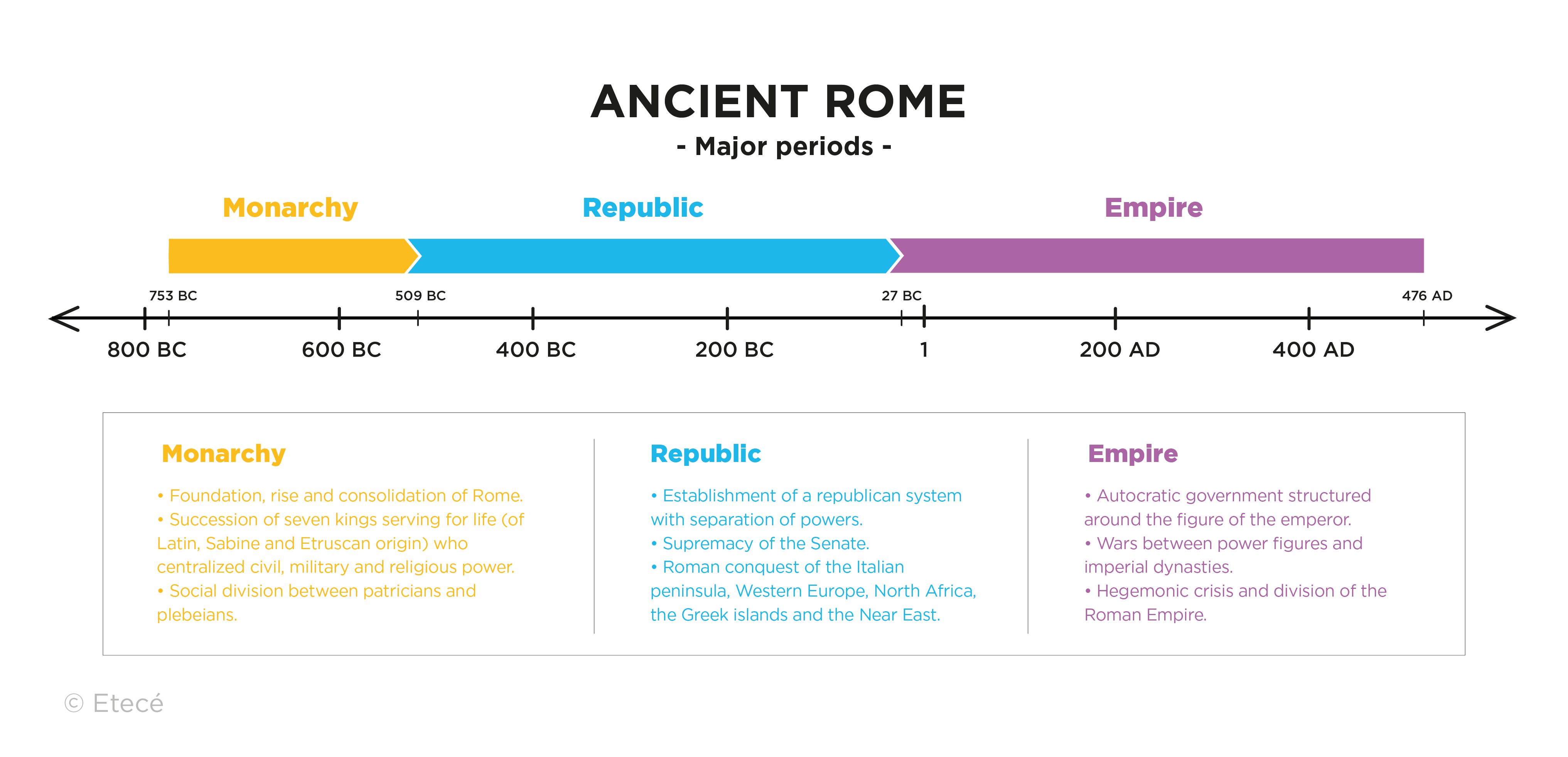
- High Empire. The first imperial period was characterized by the robustness of institutions, political stability, and a balance between the emperor and the different sources of power in the vast Roman territory. During this period, emperors managed to pacify, control, and administer the distant imperial provinces, engage in diplomatic agreements with neighboring states, and secure borders. Furthermore, they succeeded in minimizing internal conflicts and maintaining the support of the popular sectors.
- Low Empire. Starting in the 3rd century AD, Rome began to experience numerous conflicts: rebellions in different regions of the empire, invasions from other peoples on the frontiers, as well as clashes between military leaders over positions of power. This incessant warfare ravaged crops and depleted the economy. Towards the end of the 3rd century AD, Emperor Diocletian initiated an imperial division into two regions: an eastern and a western region. At the same time, in order to put an end to succession problems, each region was to be ruled by an august and a caesar. Although there were several periods of reunification, the imperial division eventually prevailed. Towards the end of the 4th century AD, the Western Roman Empire began a process of final decline. In contrast, the Eastern Roman Empire, with capital in Constantinople, stabilized and prospered.
Fall of the Roman Empire
The last emperor of Rome was Romulus Augustus, who ruled from 475 to 476 at the young age of 15. Paradoxically, he bore the same name as the founder of Rome, Romulus, and the first emperor, Augustus. He was captured and executed by Odoacer, chieftain of the Germanic tribe of Herulian origin, who took power by force, marking the end of the Western Roman Empire.
The Eastern Roman Empire continued to be a power until 1453, when its capital, Constantinople, was conquered by the Ottoman Empire.
Dynasties of the Roman Empire
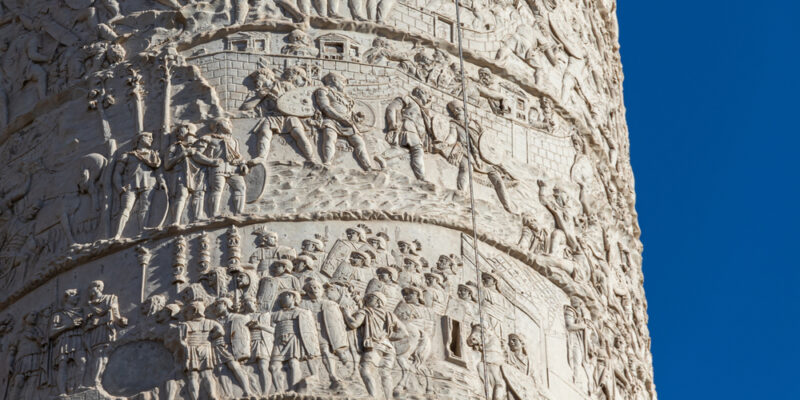
Four great dynasties ruled the Roman Empire, constituting the period known as the High Empire. These were:
Julio-Claudian Dynasty (27 BC-68 AD)
- Octavian Augustus. He was the first Roman emperor and held the longest reign, from 27 BC to 14 AD, during which he succeeded in expanding the Empire. His accession marked the end of the Republic and the beginning of an era of peace, though border wars were constant.
- Tiberius. Ruling from 14 to 37 AD, Tiberius is best known for reforming military law and creating new heavy infantry units. However, his reign declined due to the prevailing chaos and wars.
- Caligula. The third emperor ruled between the years 37 and 41 AD. Roman accounts of Caligula focused more on his sickly personality, characterized by unprecedented ruthlessness, than on his performance as an emperor. He was stabbed to death during a theatrical performance.
- Claudius. Ruling from 41 to 54 AD, Claudius proved to be a great ruler and military strategist, loved by the Roman people for his good government. Suspicion surrounds his death, and it remains unclear whether he succumbed to illness or was poisoned.
- Nero. The adopted son of Claudius, Nero ascended to the throne at the young age of 17. He ruled from 54 to 68 AD.
Flavian Dynasty (69-96 A.D.)
- Vespasian. Following the death of Nero and several civil wars, commander Vespasian came to power and ruled from 69 to 79 AD. He was the first in the lineage of Flavian emperors, which proved to be the shortest of all Roman dynasties.
- Titus. Ruling from 79 to 81 AD, Titus was noted for the construction of public buildings, like the Flavian amphitheater, known as the Colosseum. He died after two years of reign.
- Domitian. Brother of Titus, Domitian ruled from 81 to 96 AD. He was one of the most hated emperors, who the Roman populace considered a ruthless and paranoid tyrant.
Nerva-Antonine Dynasty (96-192 AD)
This period, referred to as the “golden age of Rome”, marked the zenith of Roman power, which reached its greatest territorial expansion. Its rulers were notable for their moderate use of power.
- Nerva. Ruling from 96 to 98 AD, Nerva was the first emperor of the dynasty. His leadership was viewed as wise and moderate.
- Trajan. Ruling from 98 to 117, Trajan is renowned for fostering urban development and constructing numerous buildings and monuments, such as the Forum of Trajan and the Market of Trajan.
- Hadrian. Ruling from 117 to 138 AD, Hadrian is remembered for driving numerous reforms concerning the fiscal system, slave laws, and the length of sentences. Unlike all other emperors, he conducted fewer military campaigns.
- Antoninus Pius. Ruling from 138 to 161 AD, Antoninus Pius had a peaceful reign only interrupted by a military disturbance against the British Brigantes, which prompted the construction of the Antonine Wall.
- Lucius Verus. He ruled jointly with Marcus Aurelius from 161 to 169 AD, being the first time in which more than one emperor ruled simultaneously. The circumstances of his death are unclear; while some historians suggest poisoning as the cause, others attribute it to an epidemic that ravaged Rome.
- Marcus Aurelius. He ruled jointly with Lucius Verus from 161 to 169 AD, in a period marked by constant warfare. He then reigned as sole ruler from 169 to 177 AD, distinguishing himself as a formidable commander who led a modest life. Marcus Aurelius implemented reforms in administration and civil law. He was the last of the “Five Good Emperors of Rome”. From 177 to 180 AD, he co-reigned with Commodus.
- Commodus. Sole ruler from 180 to 192 AD, Commodus was fiercely criticized for his brutal reign, being branded a tyrant by contemporaries and successors alike. His assassination, which was a conspiracy, sparked a political crisis known as "the Year of the Five Emperors."
Severan Dynasty (193-235 A.D.)
- Septimius Severus. Following the murder of Commodus, who left no heirs, Septimius Severus forcefully seized power amidst civil wars. His rule, from 193 to 198 AD, marked an attempt to continue the old dynasty. He afterwards ruled jointly with Caracalla from 198 to 209 AD, and with Geta from 209 to 211 AD.
- Caracalla. Roman emperor from 211 to 217 AD, Caracalla became notable for granting Roman citizenship to all the inhabitants of the empire. However, he turned out to be a despotic and ruthless ruler.
- Macrinus. Reigning between 217 and 218 AD, he had previously served Emperor Caracalla in civil matters. Macrinus conspired to murder Caracalla and assumed imperial power, only to be killed a year later by rebel troops supporting the rise of another military leader as emperor.
- Elagabalus. Reigning between 218 and 222 AD, Elagabalus’ government was marked by attempts to introduce abrupt changes to Roman religious and ceremonial traditions. He garnered a negative reputation for his social conduct, and criticism for promoting the cult of Sol Invictus (“Unconquered Sun”), a solar deity. He was assassinated by a conspiracy which put his cousin in power.
- Alexander Severus. The last emperor of the Severan dynasty, he ruled from 222 AD until his assassination in 235 AD. His death marked the beginning of the period known as the “Crisis of the Third Century” in Roman history.
In addition, three smaller dynasties ruled, constituting the period known as the Lower Empire. These were:
- Constantinian Dynasty (337-388 AD). Its emperors were: Constantius Chlorus, Galerius and Severus II, Constantine I the Great, Licinius, Maximinus Daia, Valerius Valens, Martinian, Constantine II, Constantius II, Constans, Magnentius, Vetranio, Nepotianus, Julian the Apostate, and Jovian.
- Valentinian dynasty (379-395 AD). Its emperors were: Valentinian I, Flavius Gratianus, Valentinian II, and Magnus Maximus.
- Theodosian dynasty (395-476 AD). Its emperors were: Theodosius I, Arcadius, Honorius, Constantius III, Joannes, Valentinian III, Petronius Maximus, Avitus, Majorian, Libius Severus, Anthemius, Olybrius, Glycerius, Julius Nepos, and Romulus Augustus.
Economy of the Roman Empire
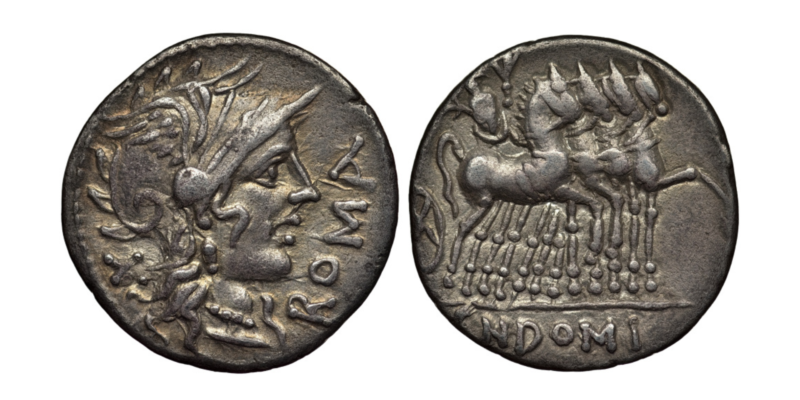
The economy of the Roman Empire was based on agriculture, with peasant and slave labor, and trade, which intensified as the empire expanded its territories.
The economy of the Roman Empire was grounded in a plethora of resources that were available within its vast territory. Through a structured taxation system and trade networks, the Romans drew on the extremely diverse regions of the empire to obtain a great variety of resources including wheat, wine, oil, iron, gold, silver, tin, copper, draft animals, slaves, ceramics, marble, timber, gemstones, and luxury handicrafts, such as perfumes, fabrics, and furs.
The Mediterranean Sea was the axis of trade and the transportation of goods. Its most important ports were Ostia (near Rome, Italian peninsula), Marseilles (Gaul), Gades (Hispania), Carthage (Numidia), Lepis (Cyrenaica), Alexandria (Egypt), Antioch (Syria), and Byzantium (Asia Minor/Greece). From these ports, land routes extended into the interior of the provinces. Additionally, the silk road reaching as far as China began in Antioch, and the spice route reaching India started in Alexandria.
During the imperial period, various gold, silver, bronze and copper currencies were used, with certain regions minting their own coins for local exchanges.
The Romans established an expansive network of roads radiating from and converging in the city of Rome. Their construction was thoroughly planned and executed, ensuring that roads would withstand the test of time and avoid flood-prone or marshy areas. These roads were used for the transportation of both goods and imperial troops.
Ancient Roman Society
Roman society was characterized by class differentiation based on wealth and family background. Originally, the Roman populace was divided between patricians (noble families) and plebeians (commoners). In the pre-imperial era, after the plebeians fought to abolish privileges, this distinction gradually lost its significance. Personal wealth became an increasingly important factor in achieving a privileged social status.
The greatest social differentiation concerned the civitas (Latin word for "citizenship"): the urban and rural spheres. Urban life revolved around commercial, artisan and government activities. Rural life was organized around urban centers, supplying them with raw materials. The majority of the population lived off the cultivation of small parcels of land, worked collectively among family members.
Roman society was slave-based. Slaves were primarily purchased to work on the estates of large landowners. They could achieve manumission (liberation), attaining the status of freedmen.
Culture in the Roman Empire
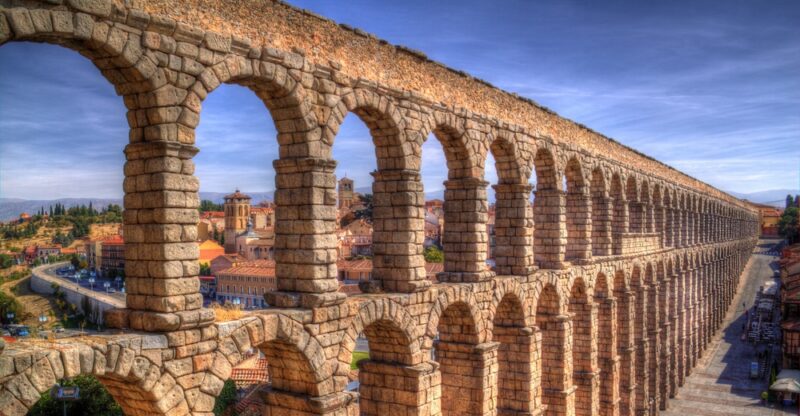
During the imperial period, Roman culture excelled in widely diverse disciplines such as architecture, literature, decorative arts, and philosophy. The knowledge and styles developed during this period laid the foundation for subsequent artists and scholars in all the Western world.
- Architecture. Emperors commissioned the construction of monumental works throughout imperial history, including buildings, monuments, aqueducts, sewage systems, roads, public baths, amphitheaters, and triumphal arches. Roman constructions were for civil and military use, and were built with slave labor but designed by professional architects and engineers. They used stone, wood and marble, bound together with a concrete-based mortar mixture.
- Philosophy. The development of philosophical studies was a hallmark of imperial Roman culture. Romans adopted two significant philosophical schools of thought from the Greeks: Stoicism and Epicureanism. Stoic philosophers, like Seneca, Epictetus, and Marcus Aurelius, used reasoning to pursue inner peace and virtue. Conversely, Epicureans aimed at the pursuit of happiness through philosophy.
- Literature. The great Ancient Roman poets like Virgil, Ovid and Horace lived during the end of the republican period and the rise of the empire. Roman nobles commissioned the composition of works to Latin writers and supported them financially. Besides literary works, the development of historical studies highlighted figures like Livy, Suetonius, and Tacitus, who recounted the events of their time.
Contributions of the Roman Empire
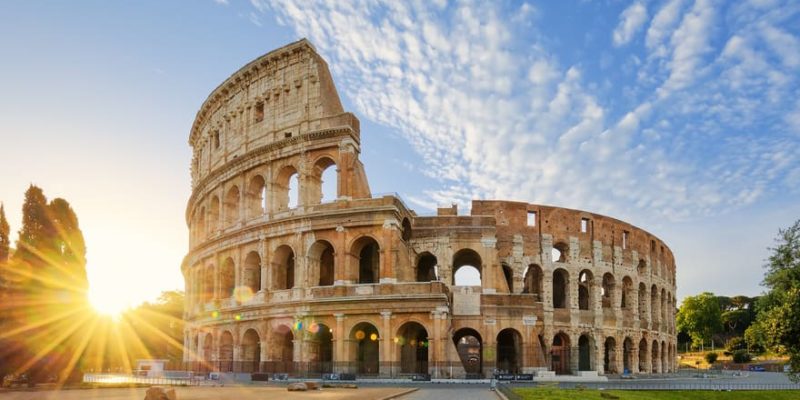
Among the most significant contributions of the Roman Empire are:
- The development of sophisticated road systems, which contributed greatly to the empire's expansion.
- The legal system, which was the basis for today's legal system.
- The Julian calendar, created by Julius Caesar in 46 BC, based on the length of a solar year.
- Latin, which was the origin of numerous major languages, such as Spanish, French, Italian, Galician, Romanian, and Portuguese, among others.
- The separation of powers in different branches, among them, the Senate.
- The Roman numeral system.
- Advances in the construction of aqueducts, which made it possible to transport fresh water to cities and maintain cleanliness.
- Sewers and drains, based on a system of sewers running alongside streets and flowing into the Tiber River.
- The use of concrete for the construction of buildings, as seen in the Pantheon and the Colosseum, which allowed them to remain partially standing to the present day.
- Advances in medicine inherited from the Greeks, to which the Romans added the development of military hospitals and the sanitation system that ultimately impacted health.
Explore next:
References
- Bravo, G. (1998). La Roma imperial. Historia de la Roma antigua. Alianza.
- Garnsey, P. y Saller, R.(1991): El Imperio romano. Economía, sociedad y cultura. Ed. Crítica.
- “The Roman Empire”. Khan Academy.
- “Roman Empire (27 BC - 476 AD)”. Civitalis Rome.
- “What are some characteristics of the roman Empire?”. Enotes.
- “Roman Empire”. Britannica.
- “List of rulers of the Roman Empire”. MET museum.
- “Roman dynasties”. Imperium Romanum.
Was this information useful to you?
Yes NoThank you for visiting us :)